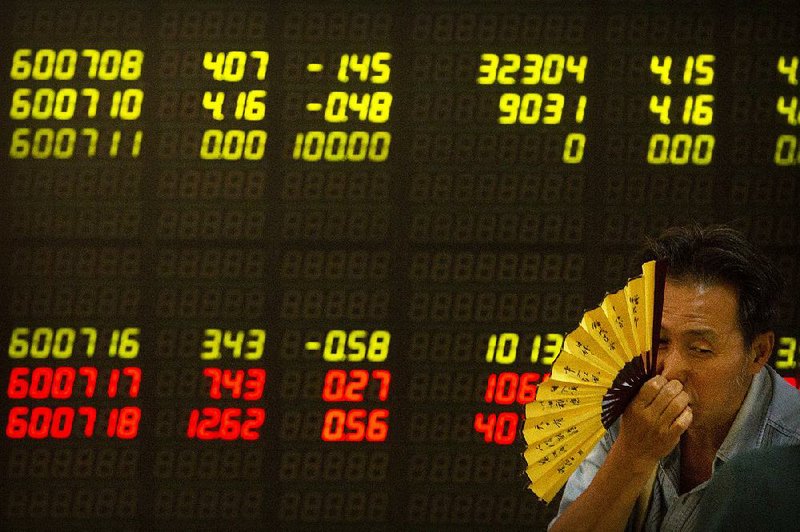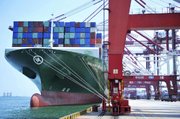WASHINGTON -- The trade war that ramped up Friday between the U.S. and China carries a risk of escalation that analysts say casts a cloud of uncertainty over investments, spending, financial markets and the global economy.
Late Thursday, the Trump administration imposed a 25 percent tariff on $34 billion in imports from China, and Beijing promptly retaliated with duties on an equal amount of American products. China accused the U.S. of igniting "the biggest trade war in economic history."
Because of the hostilities, American businesses and, ultimately, consumers stand to end up paying more for such Chinese-made products as construction equipment and machinery, and American suppliers of soybeans, pork and whiskey could lose their competitive edge in China.
These initial tariffs are unlikely to inflict serious harm to the world's two biggest economies. Gregory Daco, head of U.S. economics at Oxford Economics, has calculated that they will pare growth in both countries by no more than 0.2 percent through 2020.
But, President Donald Trump has said he is prepared to impose tariffs on up to $550 billion in Chinese imports -- a figure that exceeds the $506 billion in goods that China shipped to the U.S. last year.
Escalating tariffs are likely to slow business investment as companies wait to see whether the administration can reach a truce with Beijing. Some employers are expected to put hiring on hold until the picture becomes clearer, raising the potential of undoing some of the economic benefits of last year's tax cuts.
"Trade disruption is the greatest threat to global growth," said Dec Mullarkey, managing director of investment strategies at Sun Life Investment Management. "The direct effects will be amplified as business confidence drops and investment decisions are delayed. Markets are still hoping that the key players return to the negotiation table."
The root of the conflict is the Trump administration's assertion that China has long used predatory tactics in a drive to supplant America's technological supremacy. Those tactics include cyber-theft, as well as forcing companies to hand over technology in exchange for access to China's market. Trump's tariffs are meant to press Beijing to change its ways.
Trump is also sparring with the European Union over his threat to tax auto imports, and with Canada and Mexico over his push to rewrite the North American Free Trade Agreement. And he has subjected most of America's trading partners to tariffs on steel and aluminum.
Yet the tariffs on China, the world's largest manufacturing hub, affect a much larger share of products and a greater percentage of companies that rely on global supply chains.
Many caught in the initial line of fire -- U.S. farmers absorbing tariffs on their exports to China, for instance -- are fearful. The price of soybeans has plunged 13 percent over the past month on fears that Chinese tariffs will cut off American farmers from China, which buys about 60 percent of their soybean exports.
"For soybean producers like me, this is a direct financial hit," said Brent Bible, a soy and corn producer in Romney, Ind. "These tariffs could mean the difference between a profit and a loss for an entire year's worth of work out in the field, and that's only in the near term."
China lowered commitments to buy 366,000 metric tons of U.S. soybeans in the season that ends Aug. 31 and cut purchases by 66,000 tons for next year, according to U.S. Department of Agriculture data released Friday for the week ending June 28. About 60,000 tons originally scheduled to go to China this season will now go to Bangladesh and another 60,000 tons to Pakistan.
In the U.S., average cash prices for soybeans fell to about $7.79 a bushel this week, the lowest in almost a decade, according to an index compiled by the Minneapolis Grain Exchange.
Meanwhile in Brazil, soybeans to be shipped in August fetched $2.21 a bushel more than Chicago futures as of Friday, the widest gap since data collection in 2014. The premium has more than tripled since the end of May, according to data from Commodity 3.
Christine LoCascio, an executive at the Distilled Spirits Council, said she fears that China's tariffs on U.S. whiskey will "put the brakes on an American success story" of rising exports of U.S. spirits.
Arkansas Gov. Asa Hutchinson said Friday that the state is working with federal officials to exempt Chinese-owned Sun Paper from tariffs on its planned paper mill near Arkadelphia.
Michael Preston, executive director of the Arkansas Economic Development Commission, says tariffs on imported equipment would cost about $150 million and that concerns have already delayed the project for three months.
Sun Paper announced the mill in 2016. It has pledged to invest $1.8 billion and create 350 jobs in Arkansas.
Preston also said "a handful" of additional Chinese companies have halted possible plans to build in Arkansas because of tariff concerns.
Even before this week's actions, the prospect of a trade war was worrying investors. The Dow Jones industrial average has shed hundreds of points since June 11. But the risks are now priced into the market, and the Dow actually rose nearly 100 points Friday to 24,456.48.
China's currency, the yuan, has dropped 3.5 percent against the dollar over the past month, giving Chinese companies a price edge over their U.S. competition. The drop might reflect a deliberate devaluation by Beijing to signal its "displeasure over the state of trade negotiations," according to a report from the Institute of International Finance, a banking trade group.
The Trump administration sought to limit the impact of the tariffs on U.S. households by targeting Chinese industrial goods, not consumer products, in the first round of tariffs.
But that step raises costs for U.S. companies that rely on Chinese-made machinery or components. And it could force them to pass those higher costs on to their business customers and, eventually, to consumers.
Fans of Chick-fil-A sandwiches, for instance, may feel the effects. Charlie Souhrada of the North American Food Equipment Manufacturers said the tariffs could raise the cost of a kind of pressure cooker that Chick-fil-A uses.
One way the tariffs will squeeze farmers, landscapers and construction firms is by raising the price of excavators and loaders made by Bobcat, which uses attachments imported from China. U.S. suppliers rarely make these attachments, so the company must import them.
The Federal Reserve is picking up signs that the trade war is causing businesses to rethink investment plans. In the minutes from its June meeting, the Fed noted that some companies have delayed or reduced plans to buy or upgrade equipment.
And if Trump extends the tariffs to up to $550 billion in Chinese imports, consumers won't be able to avoid getting caught in the crossfire because the taxes would hit products like televisions and cellphones.
That's what happened to imported washing machines, which were hit by separate Trump tariffs in January. Over the past year, their price has surged more than 8 percent.
Chinese news outlets have stopped short of language that would suggest an appetite for a major escalation, such as a consumer boycott of U.S. brands.
China has become a key market for brands such as Apple, Nike, Starbucks and General Motors. Consumer boycotts have proven effective in Beijing's earlier disputes with South Korea, Japan and the Philippines. But targeting U.S. goods could be trickier. The iPhones, Chevrolets and other goods that U.S. companies sell in China are often made in China and by Chinese workers.
The U.S. trade deficit dropped in May to the lowest level in 19 months as U.S. exports rose to a record level. But the trade gap between the United States and China increased sharply.
The Commerce Department says the May trade deficit fell 6.6 percent to $43.1 billion. It was the smallest imbalance since October 2016.
Exports climbed 1.9 percent to a record $215.3 billion. Imports were up a smaller 0.4 percent to $258.4 billion.
The U.S. deficit in goods with China rose 18.7 percent to $33.2 billion. So far this year the deficit totals $152.2 billion, up 9.9 percent from the same period a year ago. As has been the case for decades, America's deficit with China is the largest imbalance with any country.
Information for this article was contributed by Paul Wiseman, Josh Boak and Martin Crutsinger of The Associated Press; by Megan Durisin and Tatiana Freitas of Bloomberg News; and by Ana Swanson and Raymond Zhong of The New York Times.
A Section on 07/07/2018

